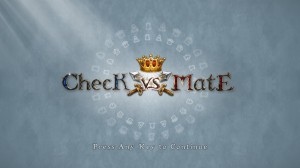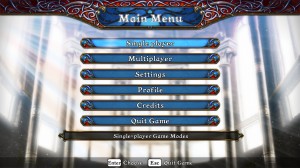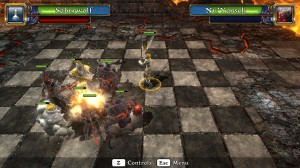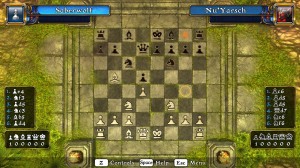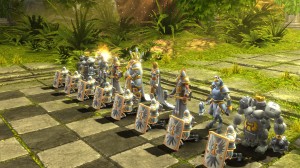Ah, Chess. There’s nothing like reviewing a game that is right up my alley, having logged countless hours at Chess tournaments and at libraries tutoring others. As a former member of the United States Chess Federation, I feel it my solemn duty to touch on this game a bit and give my two cents about how it plays.
Some of you may have heard the name “Battle vs Chess” dropped over the past year…this is actually what the game was going to be called before Interplay filed (and won) a lawsuit regarding the violation of infringement rights over their trademark, “Battle Chess.” The game has since been renamed “Check vs Mate” in the US only. The game is still titled “Battle vs Chess” in other parts of the world. Mind you, it’s not my business to get involved, but for those of you in the US who wondered where “Battle vs Chess” went, you now have your answer.
Now that your history lesson is over for today, I’d like to quickly thank Bernd Wolffgramm from TopWare Interactive for his offer in sending me a free review copy…though I had already purchased the game previously. As a Chess quote unquote “fiend”, it comes with the territory…still the offer is appreciated.
The game itself is for one or two players, and like most Chess programs, there are multiple levels of AI difficulty available in the “classic” game for those that choose to play it alone. Of the ten levels, the lowest setting is indeed pretty easy (for me) to beat, though new players to the game as a whole might find it challenging. The AI will still make decent moves on the lowest setting from time to time. I personally would have liked to have seen a level of AI that is dumb as bricks, moving pieces back and forth without a reason, just to give new players to Chess a chance to get their feet wet. To be fair, there are tutorials available that help introduce new players to the game.
Besides the “classic” game, there’s a “battlegrounds” option that allows you to take control of the attacking or defending piece (whatever the case may be). All pieces surrounding the combatants join in via AI control and assist the attacking / defending piece. You’ll be able to move the main piece around a battlefield and attack with different moves, depending on which piece you are controlling. The goal is to deplete the health of all of the enemy combatants. If the attacker wins, they capture the square as normal. If the defender wins, they keep the square and the attacking piece goes back to the square in which it came. Rather than take full control of a piece, you can choose to participate in the battle via quick time events that involve hitting keystrokes / buttons at the right time (like in Guitar Hero).
I’ve mentioned the “tutorial” option already, but there is also a “campaign” option that puts the player through fifteen missions (games) where variants exist to mix things up. “Minigames” round out the last of the options, which mainly involve challenging you to solve Chess puzzles. Multiplayer is available through LAN, local (same computer), and IP.
With all of those different game types all said and done, there are plenty of variants to choose from to make your game a bit more interesting. You can choose to have the computer randomly set up pieces or create your own setup (to a degree). I appreciate all of the different options and modes that are available for players to experiment with. It’s important to note that some of these modes are only available in multi-player games…I’m guessing some of these modes would not compute well with an AI player.
What probably stands out the most in my opinion is the 3D graphics and the ability to swivel the board around. It is fun to watch the pieces animate as they wait for their turn to move, or as they attack another piece. The backdrops and environments are incredibly pretty to look at.
So how does it stand up in the grand scheme of things? Check vs Mate does in fact remind me a little of Battle Chess in that the pieces animate and physically do battle when one piece takes another. Check vs Mate is eye candy, through and through, when compared to the later releases of the Chessmaster series. As an owner of Chessmaster 9000, I can create tournaments, adjust AI personalities, be given a Chess rating, the works. Check vs Mate doesn’t do these things, but it does what it sets out to do well…create a cinematic, realistic game where the pieces and landscapes come to life.
For those of you Chess veterans who want much more depth in a Chess program, I’d advise staying with Chessmaster 9000 or its equivalent. If you’re looking for a pretty Chess game that adds an Archon-like twist to combat along with an array of special features and modes, then it couldn’t hurt to give this a shot. Personally, I switch off between both programs, depending on my mood. Check vs Mate has some good qualities about it, but lack of some of the options that my copy of Chessmaster has keeps me from fully recommending it. To be fair, it may be enough for the casual Chess player…in the end, you’ll have to decide. Steam has a manual on the game’s page (link below)…I’d recommend checking that out to see what the game offers in full before making a decision either way.
Final Verdict: 7/10
—
You can learn more about “Check vs Mate” by visiting the following website:
http://www.topware.com/us/check-vs.-mate.html
You can find it on Steam here:
http://store.steampowered.com/app/211070/
You can view play sessions for this game here:
http://www.youtube.com/watch?v=54OamaJzghE

